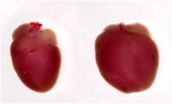Sugar boost for Oxfordshire scientists who are planning ahead for future medicines
2011-02-05
(Press-News.org) Scientists continuing to investigate a 50 year mystery have discovered another vital clue that could help pave the way for improved medicines. The results feature in a special edition of Nature celebrating the International Year of Chemistry. The findings reveal an important insight into the way carbohydrates (sugars) bond and this will influence the way drugs are designed in the future.
Using specialist laser equipment from the EPSRC-funded Laser Loan Pool managed by STFC's Central Laser Facility, Professors John Simons and Ben Davis together with co-workers from the University of Oxford, have challenged long standing theories that have until now, been based on observations and experiments made in solution. For the first time, the shapes of carbohydrates have been revealed, both when they are free from any external influence, and when they are interacting with neighbouring molecules, such as water, or protein fragments. This enables the two states to be compared. These experiments have demonstrated what happens to the sugars when they are manipulated in different ways - a crucial factor in drug design where scientists need to ensure they will be able to control the way drugs work within the body.
The sugar, was examined by computational chemistry and pulsed laser spectroscopy using an ultraviolet laser borrowed from the Laser Loan Pool. The new results, exploring sugar-protein interactions, provide the best insight so far into these crucial biological contacts.
Professor Simons said; "This breakthrough opens up a whole realm of possibilities for the way we can use this information to inform future drug development. If we can understand the structural consequences of carbohydrate protein binding we can work out how sugars might be manipulated to function at their most effective within drug development and delivery work".
Dr Ian Clark who runs the Laser Loan Pool said; "This is just one example of the huge variety of work we are able to support. This year is the 25th anniversary of the Loan Pool and over that time the Pool has loaned out lasers for everything from investigations into the oxygen content of blood to the study of sound propagation from sonic booms. In total we have given out close to 400 lasers.
###
END
ELSE PRESS RELEASES FROM THIS DATE:
2011-02-05
This declining trend is blamed on a failure of innovative drive in the industry, failure of the UK to support basic research, failure of venture capital to invest in early stage research, or failure of the Health Service to provide smart procurement.
A research centre funded by the Economic and Social Research Council (ESRC) shows that radical reform of the drugs industry regulatory system must be an important part of the solution to ensure a productive and profitable pharmaceutical sector, both globally and in the UK.
Researchers from the ESRC's Innogen centre have ...
2011-02-05
DURHAM, N.H. – From an environmental perspective, Daphnia pulex -- the waterflea – is the best-studied organism on the planet. Scientists know how this species responds to pollution, predators, day and night, making it an important model for ecological and evolutionary research. Its genome, however, remained elusive, limiting understanding of how the environment and genes interact.
Until now. An international team of researchers comprising the Daphnia Genomics Consortium, including four from the University of New Hampshire's Hubbard Center for Genome Studies, has described ...
2011-02-05
Ms. K. is vision-impaired and can't get around very well any more. Still, the 80-year-old, who lives alone, has no intention whatsoever of moving to a retirement home. Most elderly people think the same way. They want to stay in their accustomed surroundings as long as possible, where they can lead an autonomous life. What many fail to realize is that they are risking their health in the process. Cardiovascular problems are more frequent among the elderly, and the risk of falling is more prevalent: one person in three above the age of 65 falls once a year; among those over ...
2011-02-05
URBANA – A University of Illinois scientist reports that family mealtimes that contain three ingredients in the right amounts can improve the quality of life in children who have chronic asthma.
"Family mealtimes, when they're done right, are linked to many benefits for children, including a reduced risk of substance abuse, eating disorders, and obesity. In this study, we've put these mealtimes under a microscope so we can see minute by minute which factors deliver these healthy outcomes," said Barbara H. Fiese, director of the U of I's Family Resiliency Center.
Which ...
2011-02-05
Rainer Kube and his working group report in the current issue of Deutsches Ärzteblatt International (Dtsch Arztebl Int 2011; 108[4]: 41-6) on new treatment strategies in patients with colon cancer.
The findings of multicenter observational studies are a good basis for improvements to overall quality of patient care. Against this background, from 2000 to 2004 Kube and his coauthors collected data on over 31 000 patients in 346 German hospitals. From this data pool they extracted statements about the quality of care. They discovered, for example, that colonoscopy screening ...
2011-02-05
Compared to people in employment, men and women who are unemployed suffer more often and longer from both physical and emotional complaints. Why the un-employed should have health problems more often is discussed by Lars E. Kroll and his coauthor in the current issue of Deutsches Ärzteblatt International (Dtsch Arztebl Int 2011; 4: 47-52), along with a report on the findings of the GEDA study.
The GEDA study (Gesundheit in Deutschland Aktuell, or Current Health in Germany) was carried out in 2008-2009 by the Robert Koch Institute. The results showed that unemployed people ...
2011-02-05
CHAPEL HILL, N.C. – Everyone knows chocolate is critical to a happy Valentine's Day. Now scientists are one step closer to knowing what makes a heart happy the rest of the year.
It's a gene called DOT1L, and if you don't have enough of the DOT1L enzyme, you could be at risk for some types of heart disease. These findings from a study led by researchers at the University of North Carolina at Chapel Hill School of Medicine appear in the Feb. 1, 2011 issue of the journal Genes and Development.
The team created a special line of mice that were genetically predisposed to ...
2011-02-05
The first stars in the universe were not as solitary as previously thought. In fact, they could have formed alongside numerous companions when the gas disks that surrounded them broke up during formation, giving birth to sibling stars in the fragments. These are the findings of studies performed with the aid of computer simulations by researchers at Heidelberg University's Centre for Astronomy together with colleagues at the Max Planck Institute for Astrophysics in Garching and the University of Texas at Austin (USA). The group's findings, published in Science Express, ...
2011-02-05
Things are not always what they seem when it comes to fish—something scientists at the Smithsonian Institution and the Ocean Science Foundation are finding out. Using modern genetic analysis, combined with traditional examination of morphology, the scientists discovered that what were once thought to be three species of blenny in the genus Starksia are actually 10 distinct species. The team's findings are published in the scientific journal ZooKeys, Feb. 3.
Starksia blennies, small (less than 2 inches) fish with elongated bodies, generally native to shallow to moderately ...
2011-02-05
The vaccine for human papillomavirus (HPV) can prevent 90 percent of genital warts in men when offered before exposure to the four HPV strains covered by the vaccine, according to a new multi-center study led by H. Lee Moffitt Cancer Center and UCSF.
The four-year, international clinical trial, which also found a nearly 66 percent effectiveness in the general population of young men regardless of prior exposure to these strains, provides the first reported results of using the HPV vaccine as a prophylactic in men.
Initial data from this study informed the Food and Drug ...
LAST 30 PRESS RELEASES:
[Press-News.org] Sugar boost for Oxfordshire scientists who are planning ahead for future medicines


